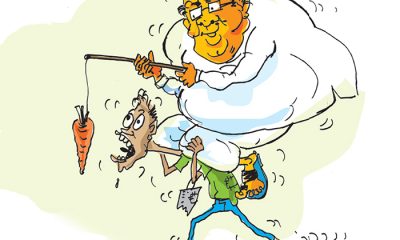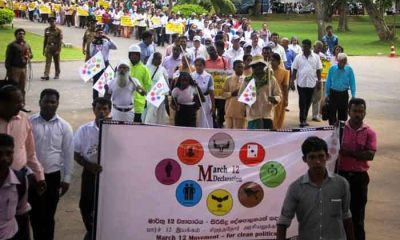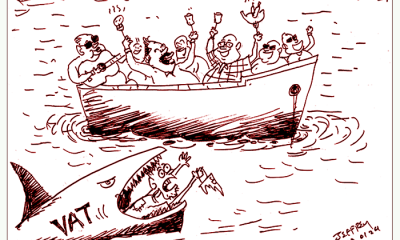News
JVP Leader questions wisdom of promoting privatisation

By Rathindra Kuruwita
Those who claimed that privatisation was the panacea for Sri Lanka’s economic ills had to present information about privatise institutions first, Janatha Vimukthi Peramuna (JVP) leader Anura Kumara Dissanayake said on Wednesday at a conference on privatisation of state assets.
Dissanayake said that the SLPP had campaigned in 2019 and 2020 on a platform of protecting and developing state assets. Therefore, if it embarked on a path of privatizing state assets, it should first go for an election and seek a new mandate.Dissanayake said that Sri Lanka had been privatising state assets since the 1980s and an overwhelming majority of those projects had led to disaster.
“In the 80s and 90s we privatised textile mills and paper manufacturing plants. Of course, there were issues with the quality of their products, but we have to understand that this was the 1980s. Now, these factories are closed, and we import almost all textiles now, burning a lot of foreign exchange. We also have a severe paper shortage and there are complaints that we don’t have paper to print school textbooks, exercise boots, term test papers and print newspapers. We privatised tea plantations, and these plantation owners claim that they can’t pay a daily wage of Rs. 1000. So, before telling us why we should privatise the rest of state-owned enterprises, the proponents of privatisation must show us the data on the impact of previous privatisation endeavours,” he said.
The JVP leader said that those who support privatisation often show Sri Lanka Telecom (SLT) as an example of the benefits of privatization. Dissanayake said that advocates of privatisation claim that before privatisation it took six to seven months to get a connection and that once the SLT was privatized everything changed.
“Is this what actually happened? If you look at the technological evolution of the telecommunications industry, the late 1980s and early 1990s saw boosts in digitization and wireless technologies. The privatization of SLT took place at a time when these technological developments were taking place.
“We benefited from technological developments in other parts of the world. The driver of efficiency in telecommunications in Sri Lanka was technological breakthroughs in the west, not privatization,” he said.
Dissanayake added that during the current economic crisis, those who represent powerful business interests have done a good job of convincing people that the best course of action is to privatize state assets.
“People are suffering and when they see the electricity bill or suffer from fuel hikes, they have been told that this is happening because the Ceylon Electricity Board (CEB) and Ceylon Petroleum Corporation (CPC) are owned by the state. They think the prices have gone up because there are too many workers in these institutions,” he said.
However, if the inefficiency of state owned enterprises is the reason for electricity and fuel price hikes, what could explain the dramatic rise in the prices of items like cement or biscuits or milk powder? the JVP leader asked.
“The government plays no role in producing cement. When it comes to milk powder, Highland only has about five percent market share and Highland is still cheaper than other brands. The advocates of privatization are silent on this. Or they tell us that milk powder is bad for the body, or we should not buy cement or biscuits. So, are we going to blame the inefficiency of the private sector for the price increase in biscuits? It is obvious that the current price hikes have little to do with the ownership,” he said.
Dissanayake said that the government is not proposing to only sell loss making institutions. Among institutions that are earmarked for privatization are profit making entities like the SLT, Sri Lanka Insurance Corporation and Sri Lankan ground handling and catering.
“Catering and ground handling departments of SriLankan make a lot of profit. I have looked at the annual reports of SriLankan catering from 2011 to 2021. They have been profitable in all years except 2020, they have been profitable even in the 2021-2022 financial year. It’s obvious why they made losses in 2020. If you look at ground handling, they are doing even better. They made a five billion rupee profit last year. The government is getting ready to sell them and I am sure there are many people ready to buy them. But what about the airline? No one will buy the airline because liabilities are higher than assets and this is a really bad time to run an airline. The government is ready to absorb all the losses of the airline, but even then there are no buyers. We will end up selling the profit-making entities and holding on to loss makers. This will only make things worse,” he said.
The JVP leader said that there are three main drivers that animate those who support privatization. Some of them are adherents of minimum government and believe that the government must not be involved in any businesses. On the other hand, the government is desperate for dollars.
“From 1980 we have failed to earn the dollars we need. In 2022, there is a gap of eight billion dollars to meet imports. If we had not defaulted we would have had to pay six billion dollars for debt servicing. How have we filled this gap? We used to make some money from tourism and foreign remittances. We filled the rest of the gap through borrowings and selling assets. Now we are scraping the bottom of the barrel,” he said.
Dissanayake added that another thing that animates privatization advocates is the opportunity to make money out of these transactions. He said that when large state institutions were privatized, those involved in the process made a lot of money.
“When Hingurana sugar was sold, the institution had 7000 acres of cane, a 300-acre plant nursery, a factory, and 70 million rupees in the bank and sugar in store. It was sold for less than sugar in the store. If we look at the current context, Minister Nimal Siripala is desperate to privatize SriLankan catering and ground handling because one of his deals went wrong a few months ago,” he said.
The JVP does not believe that the state should hold onto everything and try to involve itself in every sector, he said. However, the government has the responsibility to ensure that goods and services are available freely at a decent price, in good quality.
“We can control some aspects of the market through regulation. We can also intervene through the cooperative system. If you look at Amul, India’s dairy giant that makes billions of dollars in profit, is a cooperative. Fonterra, the producer of Anchor brand, is a cooperative. Imagine what we can do if we get small and medium scale rice millers into a cooperative and help them with finance and technology? We could easily break the monopoly of big mill owners and reduce the price of rice. Look at the tile sector, two businessmen run the sector, and now apparently people have to wait for months to get tiles. If we believed the advocates of privatization, this shouldn’t be the result of privatization. A JVP government won’t allow monopolies,” he said.
News
Navy seizes an Indian fishing boat poaching in northern waters

During an operation conducted in the dark hours of 27 Dec 25, the Sri Lanka Navy seized an Indian fishing boat and apprehended 03 Indian fishermen while they were poaching in Sri Lankan waters, south of the Delft Island in Jaffna.
The seized boat and Indian fishermen (03) were brought to the Kreinagar Jetty and were handed over to the Fisheries Inspector of Jaffna for onward legal proceedings.
News
Delay in govt. response to UK sanctions on ex-military chiefs, and others causes concern

Admiral of the Fleet Wasantha Karannagoda said that he is still waiting for the government’s response to the UK sanctions imposed on three ex-military officers, including him, and a former member of the LTTE.
The former Navy Chief said so in response to The Island query whether he was aware of the position taken by a three-member ministerial committee, consisting of Foreign Minister Vijitha Herath, Justice and National Integration Minister Harshana Nanayakkara and Deputy Defence Minister Maj. Gen (retd) Aruna Jayasekera.
The government named the committee in the wake of the UK declaration of travel bans and asset freezes in respect of Karannagoda, General Shavendra Silva, General Jagath Jayasuriya and Vinayagamoorthy Muralitharan, also known as Karuna. Maj. Gen. Jayasekera said that they inquired into the issue at hand.
Karannnagoda said that he would like to know the government’s recommendations if the ministerial committee briefed the Cabinet as per a decision taken by the Cabinet of Ministers. Karannagoda said that the issue should have been taken at the highest level as various interested parties continue to humiliate the war-winning military by targeting selected individuals.
Other sources, familiar with the issues at hand, told The Island that the government was yet to announce its stand.
Sources pointed out that the Opposition has been silent on what they called a matter of utmost national importance.
Cabinet spokesman Dr. Nalinda Jayathissa is on record as having described the UK move as a unilateral move and that committee was formed to examine the developments and recommend appropriate measures to the Cabinet.
Foreign Minister Herath told The Island the government was not successful in getting the British to withdraw sanctions. Describing the UK decision as unilateral, the Miniser said that the government conveyed its concerns but the UK didn’t change its stand.
The Island raised the issue with Minister Herath and Admiral Karannagoda in the wake of British MP of Sri Lankan origin, Uma Kumaran requesting the UK Foreign Secretary Yvette Cooper to expand on the government’s sanctions imposed on the four above-mentioned persons.
During a Foreign Affairs Committee meeting on 16 December, the MP for Stratford and Bow highlighted the lack of accountability and political will from the current Sri Lankan government to address war crimes and mass atrocities committed in Sri Lanka.
Sources said that David Lammy, who served as Secretary of State for Foreign, Commonwealth and Development Affairs at the time of the declaration of sanctions, had no qualms in declaring that the action taken against four Sri Lankans was in line with a commitment he made during the election campaign to ensure those responsible wouldn’t be allowed impunity. The UK government statement quoted Lammy as having said that this decision ensured that those responsible for past human rights violations and abuses were held accountable.
By Shamindra Ferdinando
News
Sri Lanka outlines seven key vectors of international cooperation at Moscow forum
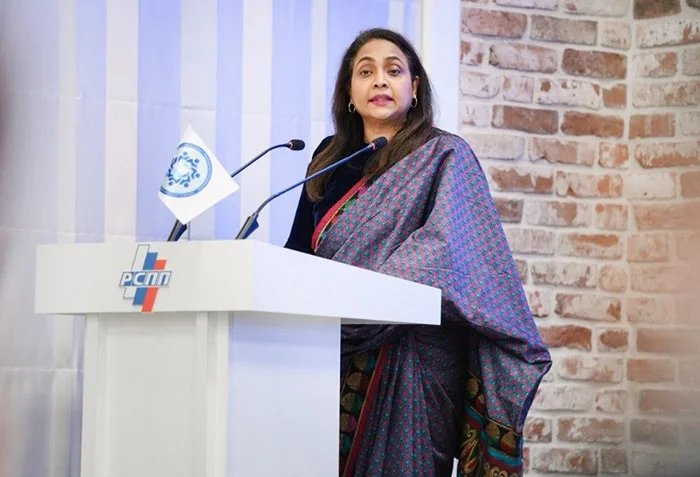
Sri Lankan Ambassador to the Russian Federation, Shobini Gunasekera recently presented a conceptual framework of seven key vectors that defined contemporary international relations and facilitated dialogue among States. She made the presentation at XI Moscow International Financial and Economic Forum held under the theme “Building Bridges: Partnership without Borders”.
In her address, the Ambassador emphasised that these vectors represent the channels through which ideas circulate, trade expands, and peace is strengthened, serving as guiding principles for cooperation amid global uncertainties. The seven key vectors highlighted were economic ties as a foundation for long-term stability; political choice and diplomacy through dialogue and multilateral engagement; security cooperation to address cross-border threats; cultural linkages through education, tourism, and professional exchanges; technological advancement, particularly in digital systems and artificial intelligence; environmental stewardship through collective action on renewable energy and climate change; and humanitarian obligations, including disaster relief and development cooperation.
Drawing on Sri Lanka’s experience, the Ambassador illustrated the practical application of these principles by highlighting the country’s strategic location in the Indian Ocean, its role as a trade and logistics hub, and its active engagement in regional groupings such as BIMSTEC and the Indian Ocean Rim Association, where the Russian Federation serves as a Dialogue Partner.
The potential for enhanced Sri Lanka–Russia bilateral cooperation was underscored, particularly through complementarities between Russia’s technological and energy expertise and Sri Lanka’s logistical capabilities and maritime infrastructure. She noted that such synergies could support joint initiatives in trade, innovation, tourism, and logistics, while cultural and scientific exchanges would further strengthen mutual understanding between the two countries.
Concluding her remarks, the Ambassador stated that sustained progress requires dialogue, mutual respect, and forward-looking partnerships capable of shaping a shared and stable future.
-

 News7 days ago
News7 days agoMembers of Lankan Community in Washington D.C. donates to ‘Rebuilding Sri Lanka’ Flood Relief Fund
-

 News5 days ago
News5 days agoBritish MP calls on Foreign Secretary to expand sanction package against ‘Sri Lankan war criminals’
-

 Features7 days ago
Features7 days agoGeneral education reforms: What about language and ethnicity?
-
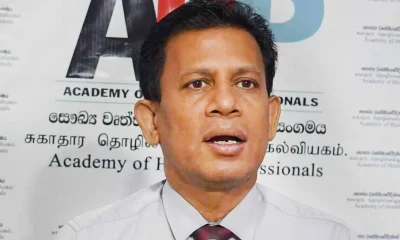
 News7 days ago
News7 days agoSuspension of Indian drug part of cover-up by NMRA: Academy of Health Professionals
-

 Sports5 days ago
Sports5 days agoChief selector’s remarks disappointing says Mickey Arthur
-
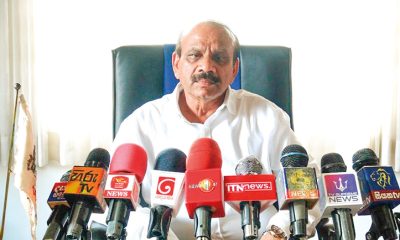
 News4 days ago
News4 days agoStreet vendors banned from Kandy City
-

 Editorial7 days ago
Editorial7 days agoA very sad day for the rule of law
-

 News7 days ago
News7 days agoUS Ambassador to Sri Lanka among 29 career diplomats recalled


